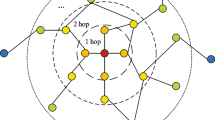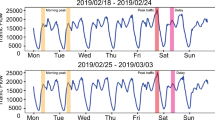Abstract
Traffic flow prediction is one of the core issues in the field of transportation planning and management. Traditional traffic flow prediction methods are limited by factors such as data sparsity, long-term interdependencies, and intricate spatiotemporal dynamics. To overcome these challenges, this paper proposes a novel predictive model called ARSTGCN, which incorporates spatiotemporal attention mechanisms and deep learning networks. Firstly, the spatiotemporal attention mechanism assigns attention weights to traffic sensor nodes, enabling the capture of spatiotemporal relationships. Dilation convolution is employed to process the temporal correlation in the data, mitigating concerns of gradient explosion and vanishing during the training of lengthy time series. Secondly, data containing spatiotemporal weight features undergoes input into the graph convolutional network, facilitating the capture of spatial dynamic correlations. The final prediction results are obtained through the utilization of the fully connected layer. Compared with the baseline model on two publicly available datasets, ARSTGCN showed certain advantages.
Access this chapter
Tax calculation will be finalised at checkout
Purchases are for personal use only
Similar content being viewed by others
References
Tanimoto, J., An, X.: Improvement of traffic flux with introduction of a new lane-change protocol supported by intelligent traffic system. Chaos, Solitons Fractals: Interdisc. J. Nonlinear Sci. Nonequilibrium Complex Phenomena 122, 1–5 (2019)
Smith, B.L., Williams, B.M., Oswald, R.K.: Comparison of parametric and nonparametric models for traffic flow forecasting. Transp. Res. Part C 10C(4), 303–321 (2002)
Zivot, E., Wang, J.H.: Vector autoregressive models for multivariate time series. In: Modeling Financial Time Series with S-PLUS®, pp. 385–429 (2006). https://doi.org/10.1007/978-0-387-32348-0_11
Ahmed, M.S., Cook, A.R.: Analysis of freeway traffic time-series data by using box-jenkins techniques. Transp. Res. Rec. 722, 1–9 (1979)
Okutani, I., Stephanedes, Y.J.:. Dynamic prediction of traffic volume through Kalman filtering theory. Transp. Res. Part B: Methodol. 18(1), 1–11 (1984)
Vapnik, Vladimir. The nature of statistical learning theory. Springer science & business media, 1999
Xiaoli, Z., Guoguang, H., Huapu, L.: Short-term traffic flow prediction method based on k-neighborhood nonparametric regression. J. Syst. Eng. 24(02), 178–183 (2009)
Ma, X., Tao, Z., Wang, Y., Yu, H., Wang, Y.: Long short-term memory neural network for traffic speed prediction using remote microwave sensor data. Transp. Res. Part C 54, 187–197 (2015)
Yao, H., Wu, F., Ke, J., et al.: Deep multi-view spatial-temporal network for taxi demand prediction. In: Proceedings of the AAAI Conference on Artificial Intelligence, vol. 32, no. 1 (2018)
Bruna, J., Zaremba, W., Szlam, A., et al.: Spectral networks and locally connected networks on graphs. In: 2nd International Conference on Learning Representations, ICLR 2014, Banff, AB, Canada, 14–16 April, 2014, Conference Track Proceedings, pp. 1–10 (2014)
Li, Y., Yu, R., Shahabi, C., Liu, Y.: Diffusion convolutional recurrent neural network: data-driven traffic forecasting. In: Proceedings of the 6th International Conference on Learning Representations, pp. 1295–1302 (2018)
Yu, B., Yin, H., Zhu, Z.: Spatio-temporal graph convolutional networks: a deep learning framework for traffic forecasting. In: Proceedings of the 27th International Joint Conference on Artificial Intelligence, pp. 3634–3640 (2018)
Guo, S., Lin, Y., Feng, N., Song, C., Wan, H.: Attention based spatial-temporal graph convolutional networks for traffic flow forecasting. In: Proceedings of the 33th AAAI Conference on Artificial Intelligence, pp. 922–929 (2019)
Geng, X., Li, Y., Wang, L.: Spatiotemporal multi-graph convolution network for ride hailing demand forecasting. In: Proceedings of the 33th AAAI Conference on Artificial Intelligence, vol. 33, pp. 3656–3663 (2019)
Tedjopurnomo, D.A., Bao, Z.F., Zheng, B.H., et al.: A survey on modern deep neural network for traffic prediction: trends, methods and challenges. IEEE Trans. Knowl. Data Eng. 34(4), 1544–1561 (2022)
Li, Y., et al.: Transformer with sparse attention mechanism for industrial time series forecasting. J. Phys. Conf. Ser. 2026(1), 012036 (2021)
Yu, F., Koltun, V.: Multi-scale context aggregation by dilated convolutions. In: 4th International Conference on Learning Representations, San Juan, ICLR, pp. 1–13 (2016)
Kipe, T.N., Welling, M.: Semi-supervised classification with graph convolutional networks. In: 5th International Conference on Learning Repre sentations. Toulon:ICLR, pp. 1–14 (2017)
David, A., Hammond, K., VB, P., Remi Gribonval, C.: Wavelets on graphs via spectralgraph theory. Appl. Comput. Harmonic Anal. 30(2), 129–150 (2011)
Wu, Z., Pan, S., Long, G., et al.: Graph WaveNet for deep spatial-temporal graph modeling. CoRR, abs/1906.00121 (2019)
Author information
Authors and Affiliations
Corresponding author
Editor information
Editors and Affiliations
Rights and permissions
Copyright information
© 2023 The Author(s), under exclusive license to Springer Nature Switzerland AG
About this paper
Cite this paper
Li, S., Li, J., Lan, J., Lu, Y. (2023). Traffic Flow Prediction Based on Attention Mechanism Convolutional Neural Network. In: Yang, Y., Wang, X., Zhang, LJ. (eds) Artificial Intelligence and Mobile Services – AIMS 2023 . AIMS 2023. Lecture Notes in Computer Science, vol 14202. Springer, Cham. https://doi.org/10.1007/978-3-031-45140-9_5
Download citation
DOI: https://doi.org/10.1007/978-3-031-45140-9_5
Published:
Publisher Name: Springer, Cham
Print ISBN: 978-3-031-45139-3
Online ISBN: 978-3-031-45140-9
eBook Packages: Computer ScienceComputer Science (R0)





